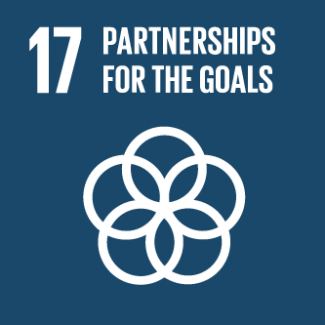Rural area internet connectivity




Business Model Description
Invest in standalone Wi-Fi stations in public areas offered to users for free and sold to sponsors in exchange for advertising, while developing alternative revenue streams from both consumers and third parties. The initiative enables to take advantage of the organizations that may benefit from high value advertising and market information gained from a growing Internet user base. (6)
Expected Impact
This initiative intends to reduce connectivity inequalities in colombian rural areas, creating new access to markets and education oportunities.
How is this information gathered?
Investment opportunities with potential to contribute to sustainable development are based on country-level SDG Investor Maps.
Disclaimer
UNDP, the Private Finance for the SDGs, and their affiliates (collectively “UNDP”) do not seek or solicit investment for programmes, projects, or opportunities described on this site (collectively “Programmes”) or any other Programmes, and nothing on this page should constitute a solicitation for investment. The actors listed on this site are not partners of UNDP, and their inclusion should not be construed as an endorsement or recommendation by UNDP for any relationship or investment.
The descriptions on this page are provided for informational purposes only. Only companies and enterprises that appear under the case study tab have been validated and vetted through UNDP programmes such as the Growth Stage Impact Ventures (GSIV), Business Call to Action (BCtA), or through other UN agencies. Even then, under no circumstances should their appearance on this website be construed as an endorsement for any relationship or investment. UNDP assumes no liability for investment losses directly or indirectly resulting from recommendations made, implied, or inferred by its research. Likewise, UNDP assumes no claim to investment gains directly or indirectly resulting from trading profits, investment management, or advisory fees obtained by following investment recommendations made, implied, or inferred by its research.
Investment involves risk, and all investments should be made with the supervision of a professional investment manager or advisor. The materials on the website are not an offer to sell or a solicitation of an offer to buy any investment, security, or commodity, nor shall any security be offered or sold to any person, in any jurisdiction in which such offer would be unlawful under the securities laws of such jurisdiction.
Country & Regions
Sector Classification
Technology and Communications
Development need
>Only 42.56% of households in Colombia have a computers and/or tablets and around and 73% have a mobile phone (1).
Policy priority
> Modernization law of 2019 intends to modernize institutions and focalize investments to facilitate the deployment of high cost infrastructure in the ICT sector. Auctions of the connectivity expectrum have taken place (2)(3).
Gender inequalities and marginalization issues
>Only 6.11% of women work in the ICT sector, without growth over the last years (19).
Investment opportunities
>The IT sector is expected to grow with prospects for U.S. companies derived from the Trade Agreement (4).
Key bottlenecks
> The main bottlenecks and obstacles include rural connectivity infrastructure development and deployment, access to technology and devices and skill development among less educated population.
Internet Media and Services
Development need
>23.8 million people have no internet (50% connectivity) presenting significant asymmetries between urban and rural: 45.7% in the head municipalities vs. and 6.2 % in scattered rural areas (1).
Policy priority
>National Development Plan: Improve internet quality and accelerate digital social inclusion deploying networks to expand connectivity. By 2022 11.8 million households (70%) will be connected and at least 80% of people over the age of 5 will use the Internet.(3).
Gender inequalities and marginalization issues
>Only 6.4% of rural households with female heads have fixed or mobile internet access (12).
Investment opportunities
>Mobile broadband has been the main growth driver of the Colombian ICT sector in recent years, as has been the case around the world (5).
Key bottlenecks
> The main bottlenecks and obstacles include capex intensive connectivity development, transport infrastructure lags.
Internet Media and Services
Pipeline Opportunity
Rural area internet connectivity
Invest in standalone Wi-Fi stations in public areas offered to users for free and sold to sponsors in exchange for advertising, while developing alternative revenue streams from both consumers and third parties. The initiative enables to take advantage of the organizations that may benefit from high value advertising and market information gained from a growing Internet user base. (6)
Business Case
Market Size and Environment
USD 100 million - USD 1 billion
10% - 15%
> OhMyFi estimates that the total potential in Colombia is +1M connection spots in the country. With +3000 connections and selling ~$2MUSD/year the total market size is $333 MUSD (13).
> Colombia: internet penetration 2000-2019. In 2019, around 65 percent of the Colombian population accessed the internet. This is over 12 percentage points more than in 2014. Colombia was also one of the South American countries with the highest mobile internet penetration rates (19).
Indicative Return
10% - 15%
Findings of the Connected Europe Broadband Facility (CEBF), that invested on rural connectivity show IRRs of around 14% (14).
Investment Timeframe
Long Term (10+ years)
According to the investment criteria established by CEBF, a Greenfield infrastructure connectivity has aninvestment period of over 10 years (world bank)(14).
Ticket Size
> USD 10 million
Market Risks & Scale Obstacles
Market - Highly Regulated
Capital - Limited Investor Interest
Capital - Requires Subsidy
Impact Case
Sustainable Development Need
> 23.8 million people have no internet (46% connectivity) presenting significant asymmetries between urban and rural: 45.7% in the head municipalities vs. and 6.2 % in scattered rural areas (1).
> Colombia ranked 131 out of 206 countries in internet speed, with an average bandwidth of 3.4 megabytes. The average speed in Taiwan is 85 megabytes (3).
Gender & Marginalisation
Only 6.4% of rural households with female heads have fixed or mobile internet access (12).
Expected Development Outcome
> Create new ways in which people can connect with one another including increased access to financial capital services (mobile banking)(7).
> Increase GDP - a 10% increase in penetration leads to a GDP per capita increase of 1.2% -1.4% (8).
Gender & Marginalisation
> Close digital gender gaps, currently 19% of women in the country have no access to the internet.
Primary SDGs addressed

9.c.1 Proportion of population covered by a mobile network, by technology
Current levels (2018): 49.9% of households have internet connectivity (9).
Target levels (2030): 100% connectivity by 2030 (9).

17.8.1 Proportion of individuals using the Internet
Current levels (2018): 60% of of the population used the internet(9).
Current levels (2018): 60% of of the population using the internet by 2030 (9).
Secondary SDGs addressed


Indirectly impacted stakeholders
People
Corporates
Public sector
Outcome Risks
>Increasing carbon footprints in the process of infrastructure deployment and increased energy use.
>Gender inequality and/or marginalization risk: Inequalities in the benefits received among men and women due to differences in skills.
Impact Risks
Drop-off risk: > Adoption of technologies might be delayed by the lack of skills of the target population.
External risks: > Violence in the area might generate damage to infrastructure projects and delay progress. > Drastic changes in the environment that are not accounted for such as earthquakes, tsunamis, and other natural disasters affecting connectivity infrastructure.
Stakeholder participation risk: > The Government, together with the National Development Plan, must fulfil its digital transformation initiative. > Technology providers (hardware and software) need to provide advice and support for the tools' proper use.
Gender inequality and/or marginalization risk: > Challenging gender stereotypes about the use of technology risks unequal access or benefits.
Impact Classification
What
Positive outcome due to increase in internet access and quality.
Who
Underserved population without internet access.
Risk
Failing to develop connectivity could reinforce poverty traps for rural population and could increase further inequalities.
Impact Thesis
This initiative intends to reduce connectivity inequalities in colombian rural areas, creating new access to markets and education oportunities.
Enabling Environment
Policy Environment
(National Development Plan): Improve internet quality and accelerate digital social inclusion deploying networks to expand connectivity (15).
(The National Plan for Rural Connectivity): aims to deploy the infrastructure to guarantee access to the Internet, and offer conditions for using this service through public access solution (16).
(ICT Plan 2018-2022): will make the internet a tool for equity, through increased connectivity and the productive use of the internet by massifying and improving the quality of internet access (17).
Financial Environment
Financial incentives: The government created a $1,4 billion COP fund (Fondo Único de Tecnologías de la Información y las Comunicaciones - FUTIC) to finance rural connectivity projects until 2022. The government created the Colombia Rural Project with a budget of over COP500,000 million for infrastructure and connectivity.
Other incentives: USAID has facilities destined to improve rural connectivity issues in Colombia.
Regulatory Environment
(Law 1978 of 2019): telecommunications network providers may execute projects for the benefit of the most vulnerable communities that contribute to closing the digital divide (16).
(Orange economy (2018)): The government aims to promote Colombia as a regional and global target market for the development of the orange economy, and to double its contribution to GDP from 3.5% to 7% between 2012 and 2022 (3).
(Modernization law): It aims to accelerate the expansion and upgrade of the network, tighten the regulatory framework and close the digital divide (3).
Marketplace Participants
Private Sector
OhmyFi is a web platform for marketing, communications, loyalty and studies in real-time through free Wi-Fi that allows users to customize, communicate and engage with clients. Lavazza, Microsoft and the Colombian National Coffee Growers Association of Colombia partnered in a digital transformation project to benefit 500k small coffee farmers in Meta region.
Non-Profit
NGOs such as Malkaia. Colnodo and USAID are working to improve access in rural areas.
Government
MINTIC: leading policies and initiatives to finance rural connectivity. Department of national planning: assigning significant budget to achieve connectivity goals.
Target Locations
References
- (1) MINTIC (2020) Indicadores básicos de TIC en los hogares. Accessed february 8th 2021
- (2) MINTIC (2019) ¿Qué es el Proyecto de Ley de Modernización del Sector TIC? Accessed february 8th 2021
- (3) Oxford Business Group (2020) - New ICT laws and attention to innovation increase Colombia's internet coverage. Accessed January 26 2021
- (4) International Trade Administration (2020) – Information and Communication Technology. Accessed January 26 2021
- (5) EMIS Insights (2020), Colombia ICT Sector Report 2021-2022.Accessed February 8th 2021.
- (19) MINTIC (2018) Así usan la tecnología las mujeres en Colombia - Accessed February 8th 2021
- (6) MinTic (2020) – Plan Nacional de conectividad rural. Accessed June 2 2020
- (7) OECD (2016) – Economical and social benefits of internet openness. Accessed May 22 2020
- (8) Deloitte (2017) – Value of connectivity: Economic and social benefits of expanding internet Accessed May 22 2020
- (9) DNP (2018) Objetivos de desarrollo sostenible. Accessed February 8th 2021
- (10) DANE (2018) Encuesta de Calidad de Vida. Accessed February 8th 2021
- (11) MINTIC (2018) así usan la tecnología las mujeres en Colombia. Accessed February 1st 2021
- (12) DANE (2020) Mujeres rurales en Colombia. Accessed February 8th 2020
- (13) La Republica (2018) – OhMyFi conecta a más de 2.5M de personas por mes. Accessed May 30th 2020
- (14)World Bank (2019) The Connected Communities Initiative experience. Accessed February 8th 2021
- (15) DNP (2017) – Plan Nacional de Desarrollo (2018 – 2020). Accessed February 8th 2021.
- (16) MinTic (2020) – Plan Nacional de conectividad rural. Accessed June 2 2020
- (17) MinTic (2017) – PlanTic (2018 – 2022). Accessed June 1 2020
- (18)MinTic (2017) – PlanTic (2018 – 2022). Accessed June 1 2020
- (19) Statista (2021) Colombia: Internet penetration. Accessed February 8th 2021















